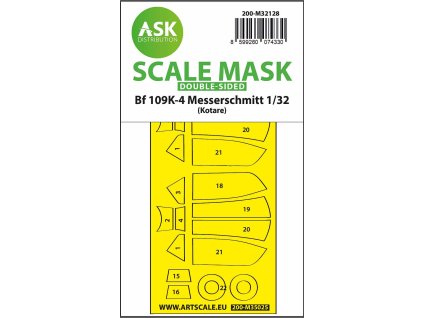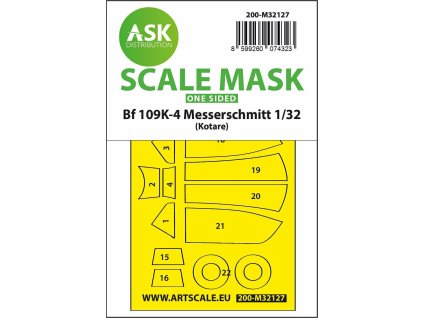1/32 Bf 109K-4 Messerschmitt - Kotare
Sculpted model of the legendary German Messerschmitt Bf 109K-4 fighter aircraft, which entered service in autumn 1944 and made a significant contribution to air combat during World War II. The model is produced by the renowned Kotare company and offers extremely detailed workmanship for modelers.
Sculpted model of the legendary German Messerschmitt Bf 109K-4 fighter aircraft, which entered service in autumn 1944 and made a significant contribution to air combat during World War II. The model is produced by the renowned Kotare company and offers extremely detailed workmanship for modelers. Kotare cat. no. K32009 / Art Scale Kit Distribution s.r.o. cat. no. 174-K32009
The model is crafted with attention to precise details and authentic surface textures, offering the possibility to assemble different marking versions and providing a faithful replica of this iconic fighter aircraft.
The kit does not include paints or glue required for assembly.
Released on 21 July 2025 - 139 high-quality injection moulded plastic parts. 31cm wingspan. All new tooling. Includes early and late production instrument panels, aerial mast, and rudders. Optional deployed and retracted slats, flaps, radiator doors, R6 camera, seats with and without moulded in safety harness detail, tall and low tailwheel struts, tailwheel doors open, wired shut and built shut, drop tank and carrier, open and closed canopies, windscreen coaming air intakes, outer undercarriage doors, wooden and metal horizontal tailplanes, and compass hatch. Wheels with weighted tyres featuring correct alignment. Fully illustrated instruction manual. High quality Cartograf decals for 3 early and late production Bf 109K-4 from 1945.
By 1944 the fame of the Messerschmitt Bf 109 in aviation history was assured forever. Produced in vast numbers and operating in a dozen war theatres, the Bf 109 had shot down more enemy aircraft than any other aeroplane. As the Nazi war machine ran riot in 39-42 the 109 became a feared symbol of Hitler’s regime, and was justly renowned for its lethal attributes in air combat.
However in mid 1944 it would have been fascinating to have a heart-to-heart conversation about the 109 with Messerschmitt AG part-owner and namesake Willi Messerschmitt.
On the one hand he was selling thousands of Bf 109Gs to the Nazi government via the Reichsluftfahrtministerium (RLM) and making good profit on them. This was partly achieved by the unconscionable use of slave labour in horrific conditions. On the other hand his engineers had completely failed to design a successful piston engine replacement for the 109. The 209 and 309 had become ignominious failures.
The ongoing competition with Kurt Tank at Focke-Wulf for single-seat fighter dominance was in full swing. It appears that very little information was shared between Messerschmitt and Focke-Wulf, either directly or via the RLM, but the Fw 190D was in flight testing by mid-1943 and was showing great promise, and the apex Focke Wulf of the war, the Ta 152, was in development.
Messerschmitt’s reputation had been badly damaged by the Me 210 debacle, and while the Me 410 was a serviceable aeroplane, it was no great advance on the Me 110 and was found wanting when P-51s roamed the German skies. The revolutionary Me 262, possibly the most beautiful aeroplane ever, had been hijacked by Hitler and his bomber obsession and the Jumo engines were a constant headache. The science fiction Me 163 was too temperamental for even gifted pilots to use effectively, and while incredibly fast was going nowhere tactically or strategically. Messerschmitt’s Me 264 “Amerika Bomber” consumed vast amounts of engineering resource for no visible result.
In this environment the Bf 109K was born.
Like Supermarine with the Spitfire (but unlike Hawkers) the Messerschmitt engineers had squeezed progressively more powerful engines into an airframe that first f lew in 1935, and didn’t change much at all. Always a handful to land and take off with its narrow-track undercarriage, this characteristic was only emphasized by the increased power on tap.
One major change from the early 109G models was the adoption of much bigger tyres. This was necessary due to the need to cope with the increasing weight of the aircraft, particularly to allow the fitment of bigger brakes. Improved ground handling was an ancillary benefit. This necessitated a bulged upper wing skin, but rather than use circular or oval bulges like the Spitfire and earlier 109s did, long-chord rectangular bulges were fitted. Remarkably these had been aerodynamically tested pre-war in the aeronautical research institute near Braunschweig, one of the most advanced in the world in 1939.
For most aircraft designs, increasing engine power leads to the need for bigger vertical tail surfaces and the 109 was no exception. A tail of greater area had already been used on some Gs, and this became standard on the K, with an attempt to preserve precious aluminium by having sub-contractors use wood as much as possible.
Daimler Benz had worked miracles to wring up to 1775 horsepower from their DB 605 engine, which was produced in slightly different versions to suit either 87 or 96 octane fuel. Water-methanol injection was standard, used to cool the fuel-air mixture in the engine cylinders and reduce pre-detonation, therefore allowing increased power for short periods of time. The methanol also stopped the water from freezing at altitude. The DB 605 D was the intended motor for the K-4, and the oil cooler and nose contours were designed to suit.
In an attempt to improve aerodynamic cleanliness outer doors were fitted to enclose the main gear, and a retractable tail wheel was fitted. Despite being first tested on the Bf 109F in 1941, the main gear doors were still not reliable in 1944, and many machines had them removed. Reliability issues also affected the tail wheel which was often fixed in the extended position and the doors wired shut.
In many respects the K can be seen as a developmental offshoot of the attempt by Messerschmitt and Daimler Benz to develop a true high altitude fighter (Höhenjager) to combat high-altitude USAAF bombers and P-51s. The Me 109H proved abortive, and the competing Focke-Wulf Ta 152 was a much better aeroplane, though it arrived too late to affect the course of the war
Many other less obvious K-4 features will be called out at the relevant points in this instruction booklet.
COMBAT SERVICE
It is a cliche, because it is true, that Allied bombing didn’t really cut off the supply of aircraft to the Luftwaffe in 44-45, it cut off the supply of fuel. The simultaneous ascent of the P-51 as the dominant fighter in the sky (ably assisted by a variety of other Allied aircraft) meant that German pilots were not safe anywhere. The clumsy Luftwaffe training scheme, which had never been as efficient as the Allied pilot-training effort, was overwhelmed.
It is commonly accepted that the K-4 entered service in October 1944 and in a few months the various factories supplied over 1400 machines to Luftwaffe units. How many of them were ever flown, let alone flew in combat, will never be known. However units across both the Western and Eastern fronts received the latest 109, and a few were even supplied to ANR units still fighting on the Axis side in Italy.
Mixed units of Gs and Ks seems to have been common, and it is doubtful that any Allied pilot, Western or Russian, would have known which version they were fighting in the air unless a turning combat ensued and the overwing bulges were obvious, and even then some G model aircraft had these.
Few first-person accounts of what it was like to fly the 109K-4 seem to have survived. There is little evidence that it was viewed as a major improvement over the G, but pilots must have been aware of which version they were climbing into because of the substantial cockpit differences. There are a few accounts describing a well-made and fully-functioning K in capable hands being able to hold its own against most Allied fighters, but the halcyon days of 1940-42 were long gone. In most instances the limited known combat records detail a sad story of losing many inexperienced pilots against overwhelming numbers of enemy aircraft flown by seasoned flyers.
Despite this, the aura of the Bf 109K still exists. It was the culmination of a decade of development by one of the foremost aircraft manufacturers in the world. In the last year of the war no Allied pilot would have taken on a 109 without respect, and in the hands of an ace the K was still a killer.
| Category: | Aircraft 1/32 |
|---|---|
| Weight: | 1.5 kg |
| Nationality: | Velká Británie |
| Period: | World War II |
| Scale: | 1/32 |
| Typ: | Letadla |
Be the first who will post an article to this item!




















